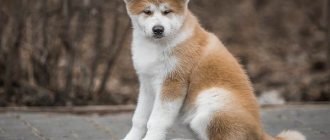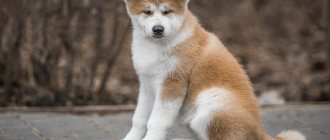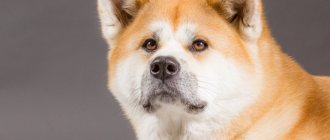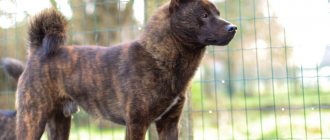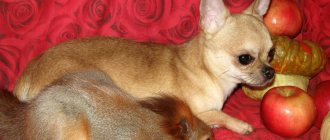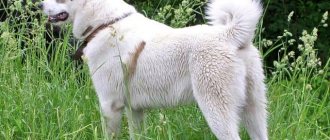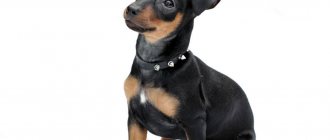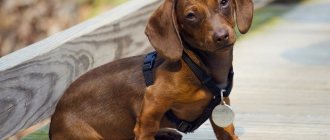Many people would like to have an Akita Inu pet, but their living conditions do not allow them to keep a dog of such a large size. However, there is a way out: after all, there is a breed of dog in the world that looks almost the same as the Akita Inu, but is about half its size.
This mini version of the Akita is suitable for apartment living and is easier to feed and train. However, she has some breed characteristics that need to be taken into account by those who are planning to purchase her.
What is the name of the small breed, its history
In fact, it would not be entirely correct to talk about this miniature dog as a mini Akita, since at present it is a separate breed called the Shiba Inu. Like most other traditional Japanese breeds, it got its name from the name of the area in which it was bred.
“Dog from Shiba” - this is how it can be translated literally. However, there are other versions. According to one of them, the Shiba got its name from the word “shibafu”, which can be translated as “tuft of grass” by analogy of the color of this animal with the color of sun-dried grass. also a hypothesis that the name translates as “dog from the bush forest” .
In any case, it should be recognized that the Shiba is a very ancient breed. Dogs similar to her were found on the territory of modern Japan already three thousand years ago. The history of this breed is noteworthy in that mini Akitas were bred to guard monasteries and only later were they adapted for hunting. The monks treasured these dogs and made sure that the puppies did not fall into the hands of ordinary people, even the nobility.
NOTE!
The monks especially valued silence in their dogs, as this helped maintain the silence and atmosphere of serenity so characteristic of Japanese monasteries.
But at the same time, Shiba Inu had to be fast, resilient and have excellent reactions necessary for hunting. For a long time they were bred exclusively in monasteries, but, in the end, these dogs somehow ended up outside their walls and almost immediately became as beloved by local residents as the Akita Inu.
Official breeding of the Shiba in Japan began in 1928, when the Society for the Preservation of Aboriginal Breeds was founded, and these dogs themselves were declared a national treasure. The FCI recognized the Shiba Inu as a breed in 1964. And in Russia, the first representatives of this breed appeared at the very end of the 20th century.
Akita Inu puppies
Interesting fact: a dog's name depends on the size of his mother's litter. If this is the first birth, then the nicknames are chosen with the letter “A”, if the second - with “B” and so on. Read more about nicknames for female dogs and nicknames for male dogs.
In the first weeks after birth, puppies feed exclusively on mother's milk and gradually the breeder adds complementary foods. You can buy an Akita no younger than eight weeks of age. By this time, his diet is replenished with food or natural products.
Choosing a puppy
If you want to buy an Akita puppy, you don't have to go to Japan. In order to choose a friend for yourself and your family, just contact Russian nurseries. All breeders are controlled by curators who monitor the purity of the breed, so the risk of encountering a non-purebred dog is low. However, it is worth deciding in advance not only the gender of the future pet, but also carefully studying the breed standards.
Already at 2 months of age, the main characteristics of the breed appear - erect ears, curled tail, color and width of the skeleton. Knowing the main distinguishing features, you can choose a true Japanese Akita.
Pay attention to the puppies' behavior. With a playful and mischievous disposition, these are the real Akitas. As dogs grow up, they become more reserved, but as children they are active and curious. A modest and quiet puppy is not the best representative of the breed.
Appearance, standard and photo
The Shiba is a relatively small dog with a proportional, harmonious and moderately muscular build . The ratio between height at the withers and body length is 100:110 in males; in females the body format is somewhat more elongated.
The head is of a size commensurate with the body, with a wide skull, a clearly defined transition to a muzzle slightly tapering towards the end. The cheekbones are well defined, and there is a small longitudinal groove on the forehead. The eyes are slightly slanted, small, triangular in shape, their color is one of the shades of dark brown.
The ears are erect, medium-sized, triangular, turned forward. The nose is black. The neck is strong and quite muscular. The back is strong and straight. The stomach is tucked, but not excessively. The tail is set high, curled into a ring on the back.
The limbs are smooth and parallel, moderately muscular and quite strong . The paws are arched, tightly compressed, with elastic and durable pads and dark claws. The coat is very dense and thick, the so-called “wild” type: it consists of a straight and fairly rigid spine and a soft, dense undercoat.
Desirable colors: red, sesame, red sesame, red sesame, black and tan. Sand and white are acceptable, but not desirable.
NOTE!
Sesame color is one of the varieties of zonal color, in which the upper part of the hairs is blackened by no more than 50%.
For any color, “urazhiro” is required - lightening of the fur on the sides of the muzzle, cheekbones, neck, chest, belly, limbs and lower part of the tail.
Next you will see how representatives of this breed look in the photo:
Character
The Mini Akita has a strong, balanced character . In its historical homeland, it is believed that this dog should have three main traits: good character, bold audacity and simplicity. At the same time, good character should be understood as loyalty, the ability to obey and gentleness.
Bold audacity means that the Shiba is a calm and balanced dog, but at the same time, distinguished by courage and bravery. Well, by simplicity, first of all, you need to understand sincerity and honesty.
Mini Akita Inu is very smart and quick-witted; these dogs are characterized by intelligence and innate nobility. She is quite good-natured and affectionate towards her owners, but at the same time she is somewhat headstrong. But at the same time she is cunning and resourceful; her character reveals almost feline independence and the ability to make independent decisions.
IMPORTANT!
The Shiba Inu will protect its owner and his family to the last, these dogs make wonderful and sensitive, albeit rather silent watchmen. At the same time, the mini Akita Inu is not averse to playing and even has a certain sense of humor that allows her to make very artistic faces.
Dog handler's opinion
Expert opinion
Kozhevin Semyon Kirillovich
Expert dog handler.
“The Shiba Inu is a representative, albeit similar to the Akita, but still a different breed. These are medium-sized dogs, mostly bright red in color, distinguished by a bold, but at the same time balanced and calm disposition, intelligent and friendly towards their owners. They are better suited for living in an apartment than their larger “relatives,” but you need to remember that these dogs need significant physical activity.
It’s not difficult to keep a mini Akita, but you need to take into account that these dogs need a special diet, since during the long isolation in their historical homeland, the Shiba Inu has developed special taste preferences.”
Advantages and disadvantages
pros:
- A devoted companion and reliable guard.
- Its small size makes this dog very suitable for apartment living.
- Attractive, quite exotic appearance.
- They can live in the yard or in an enclosure all year round.
- Their fur does not emit unpleasant odors.
- Very smart, funny, quick-witted and, at the same time, intelligent.
Minuses:
- Due to its willfulness, it requires a special approach to training.
- Significant physical activity is required.
- Needs a special diet.
- Can play pranks when left alone.
- Due to its highly developed hunting instinct, it can attack small animals and birds.
Shiba Inus do not get along very well with other dogs and can even start fights with them.
Care and maintenance
Mini Akita Inu can live both in a house and in an apartment. The thick and dense double coat of these dogs allows them to withstand the cold well, but when kept in a yard or enclosure, you need to make sure that the pet has an insulated booth.
In the apartment, the Shiba Inu should have its own place , away from heating devices and located away from drafts. The place should not be located on the passage, but where the dog could easily observe what is happening in the apartment.
You need to walk your mini Akita twice a day, and, preferably, give the dog the opportunity to run without a leash in a closed area. Caring for her is simple: just comb your pet’s fur from time to time and occasionally bathe it. Moreover, it is recommended to wash your Shiba Inu with soap no more than 2 times a year.
IMPORTANT!
Ears and teeth should be cleaned as they become dirty, and nails should be trimmed when they become so long that they begin to click on the floor.
Interesting Facts
In its homeland, the Akita is a cult dog. She is considered an excellent companion, protector of the home, and a symbol of good health. There is a tradition, when a child is born in a family, to give the parents a figurine of an Akita. Such a gift symbolizes the wish of happiness, health and longevity. A person receives the same souvenir if he is very sick. Friends and relatives express their support for him in this way and wish him a speedy recovery.
The Japanese Akita is one of the world's most popular dog breeds used as companions. She competes with Labradors for the title of “best companion.” In the USA, these balanced, friendly dogs are specially trained and used in medical centers for the rehabilitation of people who have suffered serious illnesses or are struggling with serious illnesses. Akitas provide convalescents with emotional support in the fight against the disease. They are used for the same purpose in nursing homes.
If you look at an Akita Inu, the dog may appear to be smiling. The point is the special structure of the jaws.
On the Akita's paws, the toes are pressed tightly together. It's like they grow together. Due to this, it seems that they are connected by membranes. The special structure of the paw allows the dog to correctly distribute its weight so that it can easily move through the snow. For the same reason, Japanese dogs feel great in water - they swim well.
In 1977, the Akita Inu Museum was established in Odate, Japan. The exhibits presented there tell the history of the breed. The office of the Society for the Protection and Preservation of Akita Inu is located in the same city. This organization annually holds breed championships and selects the best representatives.
In 2012, Akita Prefecture Governor Norihisa Satake presented an Akita Inu puppy to Russian President Vladimir Putin. The gift was presented as a token of gratitude for Russian assistance in eliminating the consequences of the 2011 earthquake. The puppy was given the name Yume. Translated from Japanese into Russian as “dream”.
What is the difference from the standard?
External differences
- Height and weight . The Shiba Inu is approximately half the length and three times lighter than the larger Akita Inu.
- Color . Black and tan coloring is typical only for Shibas, but, on the other hand, only standard Akita Inus are brindle.
- Body type . Shibas look somewhat shorter-legged than Akitas. At the same time, due to their lighter frame, they do not seem massive.
- The structure of the head and muzzle . If the head of a standard Akita is somewhat similar to a bear's, then the outlines of the Shiba's muzzle clearly show fox-like features.
Temperament and character
Despite the fact that here too these breeds have a lot in common, for example, a calm and balanced disposition, intelligence and nobility, it should be noted that the Shiba Inu is somewhat more playful and active than the Akita. These dogs are characterized by a kind of humor: they love to make faces, which cannot be said about the Akita - they are more restrained and majestic.
The main difference in the character of these dogs is that the Shiba Inu has more hunting qualities than watchdogs, however, this does not make it a worse guard than its larger “relative”.
What happened to Hachiko?
The story about Hachiko could remain unknown to the general public. The Japanese professor's relatives left their home and tried to place the dog in a new family. The dog was adopted by a gardener who worked for a long time in the house of Hidesaburo Ueno. But no one can get through to Hachiko’s heart: every time he ran away, returned to the place of his waiting.
The railway station employees noticed that every day he was waiting for the owner, and the wait was not ending in success. Visitors, sellers, and workers began to feed the dog, amazed at his unconditional devotion and perseverance. One of the passers-by was interested in Khati for a long time, sent his photographs and notes to newspapers and magazines. So, in September 1932, a note dedicated to this devoted pet was published in the national publication “Asahi Shimbun”.
It was this article that made the animal famous throughout the world. A huge number of Japanese began to come to Shibuya Station to see for themselves. Thus, the history of Hachiko spread to every corner of Japan and beyond. Already in 1933, there was not a single Japanese who did not know about the dog that was waiting at the station for its owner. From that moment on, the phrase “loyal as a hatiko” began to be used.
Monument to a dog at the station
In 1934, a monument was erected near the station ticket offices at the waiting area for Khachiko. All members of the Hidesaburo Ueno family (grandchildren, children), as well as their devoted four-legged pet, were present at the opening of the sculpture. The ceremony was held a year before Hachiko died. Where and when did the most faithful, persistent dog die? Life on the street left a negative imprint on the animal, and on March 8, 1935, Khachi passed away in the same place where he spent the last 9 years of his life. Japan has recognized March 8 as a day of national mourning.
All citizens of the state said goodbye to Hachiko as a sign of boundless love, devotion and fidelity. Hachiko died far from his loved one, but the ashes were buried next to him. The Japanese believe that the four-legged pet was reunited with its owner after its death. The stuffed dog is kept in the National Museum, which is located in Tokyo. Every person can be convinced of this, because the exhibit has been preserved to this day.
Although the Akita Hachiko Monument was destroyed during World War II, the Japanese were able to restore it. In 1948, the son of the author of the first sculpture repeated the work. Today it is a historical place that is visited by a huge number of tourists. The story of how Hachiko was waiting for his friend is written in a Japanese school textbook. Breed Features
The breed of dog in the film Hachiko and from the real story are not different from each other. The dog presented to the public is Akita or Akita Inu. Like Hachiko, this Japanese dog breed is characterized by loyalty. Representatives of the species protect their owners and household members with special responsibility. They are smart and independent. Hachiko in the film loved his master because the professor earned his respect. It’s the same in real life: the Akita’s respect must be earned, then you will have a faithful and obedient pet.
Friends reunion
The Hachiko dog breed demonstrates impeccable protective qualities and aggression towards other dogs. The latter problem can be easily solved with early training and socialization. The story of Hidesaburo Ueno and Hachi confirms this, since the dog was the eighth pet of the family. If you put love, effort and time into raising an animal, you can end up with a wonderful, intelligent companion with an unwavering sense of loyalty. What breed should I choose for a friend? Akita Inu or large Japanese dog - loyalty, respect and unbreakable love that must be earned.
The story from the film Hachiko shows what boundless devotion and true friendship is between an animal and a person. What dog can wait for its owner for 9 years and 9 months in a row? The Japanese treat Hachi with special reverence, so when he died, national mourning was declared throughout the country. In 2015, staff from the Faculty of Agriculture at the University of Tokyo unveiled a statue that commemorates the long-awaited meeting between Professor Hidesaburo Ueno and Hachi at Shibuya Station. So two loving hearts were able to reunite forever.
Hachiko is a symbol of fidelity and love throughout the world, it is a global heritage.
Read further:
Japanese Fighting Dog: Loyal, Hardy Protector and Companion
Japanese Akita: loyal friend and reliable companion
Einsteins in the dog world: TOP 20 most intelligent breeds
Skye Terrier
Markusha
The Japanese Chin is a sweet and kind dog for those who need a good friend
Proper feeding
Creating the right diet for a Shiba Inu can sometimes be difficult . The fact is that these mini Akitas, being natives of Japan, are accustomed to completely different products than dogs of other breeds.
In their historical homeland, they mainly feed on rice, fish, seafood and algae. They do not tolerate many types of meat well: they cause allergies in mini Akita Inu. It is also better not to give them most cereals, except rice, as they lead to digestive upset.
NOTE!
Having bought a puppy of this breed, you need to feed him the same thing that he ate at the breeder’s house, since independent experiments with the selection of a new diet for a mini Akita are unacceptable.
Ready-made low-quality food containing soy is also not suitable for Shiba Inu. Of course, many dogs of this breed quite successfully eat branded food, but only those that do not contain harmful components or products that cause allergies.
It also makes sense to consult with the breeder about the frequency of feeding. Typically, puppies are fed 6-4 times a day, but subsequently the number of feedings is reduced to two.
Price
Not everyone can become the owner of a high-breed Japanese dog, since it is quite expensive. There is a nursery in Moscow where purebred Akita Inus are bred. For each puppy they issue a full package of documents, including a passport and pedigree. When making a purchase there, you can be sure that you are not getting a “pig in a poke.” The average price of an Akita Inu in the Russian Federation is 50 thousand rubles. Adult champions are sold at a higher price, 60-70 thousand rubles.
